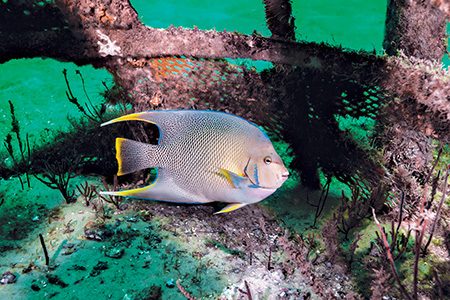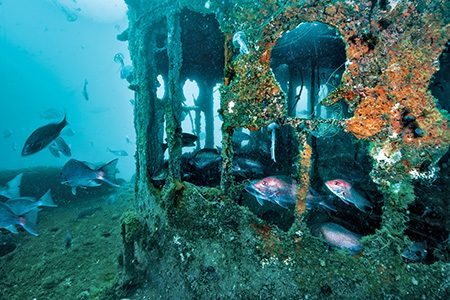Following the white sand beaches and emerald waters along the Florida Panhandle leads to a diverse set of wrecks and artifacts ranging from oversized sculptures to the largest purpose-sunk wreck in the U.S. This area of Florida is known as the Emerald Coast, and the visibility in this part of the Gulf of Mexico is superior to that along the Louisiana and Texas coastlines.
Offshore charters offer trips to dozens of dive sites in the Florida Panhandle Shipwreck Trail, one of the world’s largest artificial reef programs. Tropical fish and wildlife — such as splendid toadfish, red-lipped batfish, and groupers — reside within the wrecks. Local lionfish hunts help reduce the invasive species population, and larger animals such as dolphins and even the occasional whale shark pass through during summer.
Destin is at the center of the Emerald Coast and is flanked by Pensacola to the west and Panama City to the east. The USS Oriskany is a premier dive destination from historic Pensacola, while Destin is a significant tourist destination that provides access to smaller attractions such as the Underwater Museum of Art and the Miss Louise tugboat. Diving from Panama City centers around artificial reefs that offer experiences ranging from beginner to advanced and technical diving, with wreck penetration available to those with the proper certification.
The top of the wheelhouse on the Black Bart is about 40 feet (12 meters) deep, so open-water divers can visit the upper exterior of the former oilfield supply ship. The freighter Red Sea is at the same depth as the Black Bart — 75 feet (23 meters) to the bottom — but is upright, with the top also at 40 feet (12 meters). Deep wrecks of Navy ships are within advanced recreational limits, including the minesweeper USS Strength at 60 to 80 feet (18 to 24 meters); the USS Accokeek, a 143-foot (44-meter) tug at 74 to 100 feet (23 to 30 meters); and the 205-foot (62-meter) USS Chippewa tug at just more than 100 feet (30 meters). The FAMI Tugs were originally sunk to rest about 30 feet (9 meters) apart until Hurricane Michael set one tug atop the other.
Other wrecks near Pensacola include the World War II Allen Liberty ship, the Charlie Brown barge, and the cargo steamer SS San Pablo, known locally as the Russian freighter. The LuLu is a steel-hulled coastal freighter intentionally sunk in 2013, with the top of the wheelhouse within recreational diving limits. Hurricanes have since twisted this ship in two directions, but it is still a significant artificial reef.
The New Venture is a 250-foot (76-meter) research vessel sunk near shore in 2018 that has since become a Pensacola wreck diving destination. All parts of the ship are accessible from wide openings cut in the sides. Recreational divers can access the entire ship, which sits at 120 feet (37 meters) with the top at about 60 feet (18 meters), and technical divers can plan longer and more complex dives. The top deck and stern hold are its most recognizable features. Nearby oil rigs and Army tanks provide second dive locations with more mature wildlife aggregations, though you can usually see jacks and snappers on the New Venture.
Beyond wrecks, the natural limestone reefs are popular dive sites, including White Hill Reef, Amberjack Rocks, Shoreline Reef, Long Reef, and Triplets. These deep reefs converge in Destin and start at about 80 feet (24 meters).
USS Oriskany (CVA-34)
The world’s largest purpose-sunk wreck, which lies off the coast near Pensacola, deserves its nickname — the Mighty O — from both the required dive planning and its historical significance. The aircraft carrier spent most of its 25-year Navy service stationed in the Pacific. The Navy decommissioned the Oriskany in 1976, by which time it had earned two battle stars for service in the Korean War and five for service in the Vietnam War. Only two other aircraft carriers in the world are accessible to divers, but the Mighty O dwarfs the USS Saratoga in Bikini Atoll and the HMS Hermes in Sri Lanka.
This 911-foot (278-meter) wreck is an impressive presence in the water. All you can see when looking up from the sand is a giant, black wall looming above. Some pieces of the wreck remain scattered from when it sank. Although the tower is within recreational limits, starting at about 85 feet (26 meters), the bulk of the ship is accessible only to technical divers.
Dive charters moor on the tower, which means easily reaching the bow or stern requires diver propulsion vehicles. The hangar bay is a swimmable technical dive with impressive views at 175 feet (53 meters) deep. This area held some of the 80 planes this aircraft carrier stored.
Much of the interior has deteriorated and rusted through, especially on the flight deck, since the ship was sunk upright in 2006 as an artificial reef. Divers should be cautious when going through any part of the wreck. It is just over 22 nautical miles southeast of Pensacola and is exposed to all elements, so swift currents often surround the wreck. It is best to stay near the structure at all times, and entering some holds, such as the hangar bay, keeps divers out of the current.


Tugboat Dives
Sea life is abundant on three local tugs near Pensacola: the Navy Tug, 151 Tug, and 105 Tug. The Navy Tug is an open wreck with abundant fish and some penetration in the wheelhouse. Each tugboat takes only one dive to explore it in its entirety, which is part of why the tugs are a desirable and attainable introduction to wreck diving.
The animal density makes them compelling dives, with schools of spadefish so thick they obscure the wrecks. Divers can find unusual bottom dwellers and rays on the 85-foot (26-meter) sandy bottom just beyond the boats.
Underwater Museum of Art
The Underwater Museum of Art is the smallest attraction among the mighty wrecks along the Florida Panhandle. This permanent sculpture exhibit was created in 2018 to provide a marine habitat for a 1-acre seabed off the coast of Grayton Beach State Park. Sculptures are limited to 12 feet in all directions, and all rest on the sand at 60 feet (18 meters) and a mile from shore to allow navigable waterways.
This relatively recent installation has attracted some permanent residents, including porcupine fish, butterflyfish, and angelfish. Reef and nurse sharks frequent the area as they rise from the nearby offshore reef system.
An annual public submission process brings new sculptures, so every year is different. Divers should book charters in advance to visit these larger-than-life art pieces. Some sculptures are interactive for scuba divers, such as the genie lantern with a hole for blowing bubbles out the spout. Many sculptures feature underwater themes, such as sea creatures, an homage to the Aqua-Lung, and even a statement about plastic in our oceans.



How To Dive It
Conditions: May to September offer the best conditions for diving, with calmer water and better visibility. Consider exposure protection for water temperatures between 60°F and 76°F (16°C and 24°C) during summer. Several local dive shops offer rental equipment and charters. Be aware of invertebrate life that can sting, such as jellyfish, in these nutrient-rich waters.
Visibility: Visibility is best offshore and can be up to 80 feet (24 meters), though there are limited reports of 100-foot (30-meter) visibility. Inshore visibility averages 20 to 40 feet (6 to 12 meters) but can be very low following storm activity.
Explore More
See more of what the Florida Panhandle offers divers in these videos.
© Alert Diver — Q1 2024